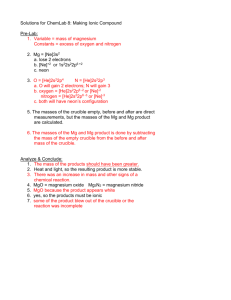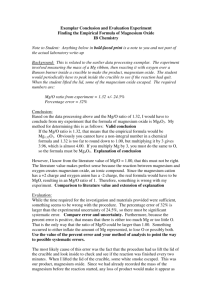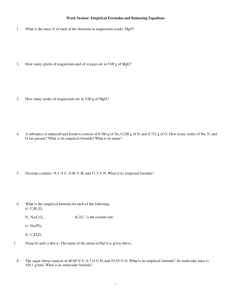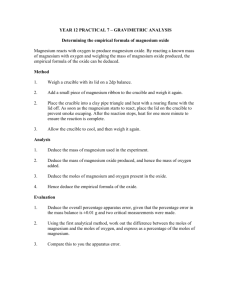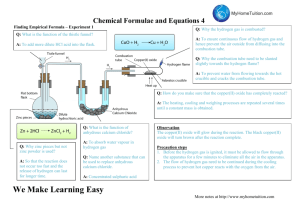Lab3.1 Empirical Formulas
advertisement
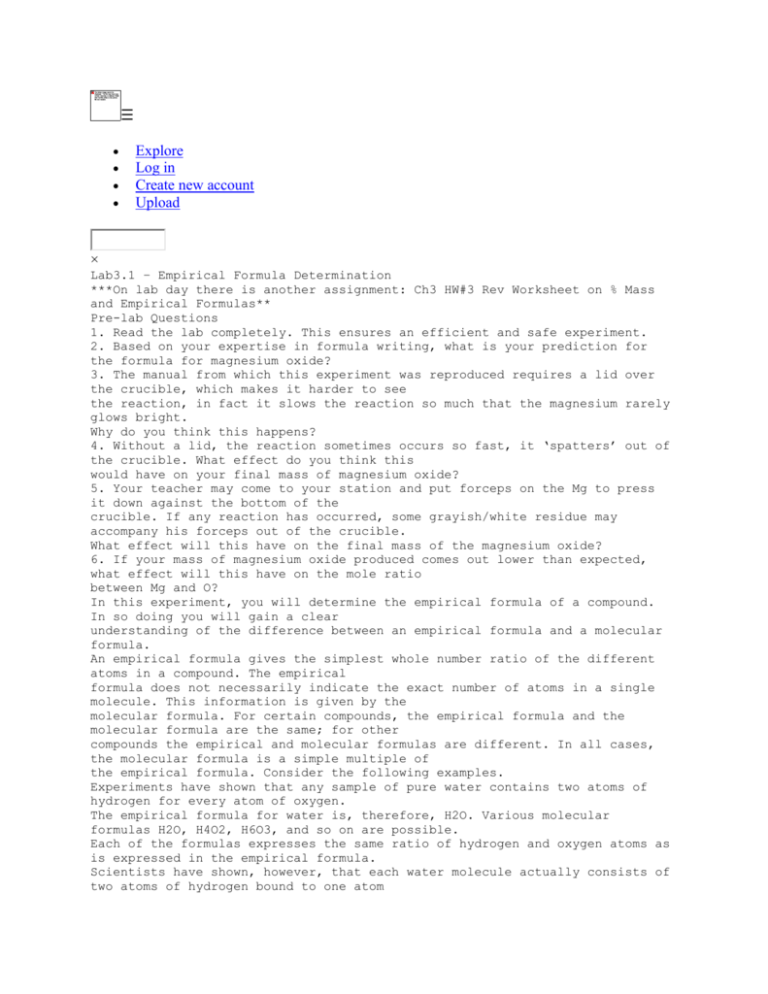
☰ Explore Log in Create new account Upload × Lab3.1 – Empirical Formula Determination ***On lab day there is another assignment: Ch3 HW#3 Rev Worksheet on % Mass and Empirical Formulas** Pre-lab Questions 1. Read the lab completely. This ensures an efficient and safe experiment. 2. Based on your expertise in formula writing, what is your prediction for the formula for magnesium oxide? 3. The manual from which this experiment was reproduced requires a lid over the crucible, which makes it harder to see the reaction, in fact it slows the reaction so much that the magnesium rarely glows bright. Why do you think this happens? 4. Without a lid, the reaction sometimes occurs so fast, it ‘spatters’ out of the crucible. What effect do you think this would have on your final mass of magnesium oxide? 5. Your teacher may come to your station and put forceps on the Mg to press it down against the bottom of the crucible. If any reaction has occurred, some grayish/white residue may accompany his forceps out of the crucible. What effect will this have on the final mass of the magnesium oxide? 6. If your mass of magnesium oxide produced comes out lower than expected, what effect will this have on the mole ratio between Mg and O? In this experiment, you will determine the empirical formula of a compound. In so doing you will gain a clear understanding of the difference between an empirical formula and a molecular formula. An empirical formula gives the simplest whole number ratio of the different atoms in a compound. The empirical formula does not necessarily indicate the exact number of atoms in a single molecule. This information is given by the molecular formula. For certain compounds, the empirical formula and the molecular formula are the same; for other compounds the empirical and molecular formulas are different. In all cases, the molecular formula is a simple multiple of the empirical formula. Consider the following examples. Experiments have shown that any sample of pure water contains two atoms of hydrogen for every atom of oxygen. The empirical formula for water is, therefore, H2O. Various molecular formulas H2O, H4O2, H6O3, and so on are possible. Each of the formulas expresses the same ratio of hydrogen and oxygen atoms as is expressed in the empirical formula. Scientists have shown, however, that each water molecule actually consists of two atoms of hydrogen bound to one atom of oxygen. Therefore, the molecular formula for this compound is H2O. For water, the empirical and molecular formulas are identical. For other compounds, the empirical and molecular are different. Consider hydrogen peroxide. This compound contains one atom of hydrogen for each atom of oxygen, and its empirical formula is HO. There is, however, no stable molecule having formula. In fact, it has been shown that individual hydrogen peroxide molecules contain two atoms of oxygen. The molecular formula of this compound is, therefore, H2O2. In some cases, two or more different compounds share the same empirical formula. This is true of acetylene and benzene. Each of these compounds has the empirical formula CH. The molecular formula of acetylene, however, is C 2H2, while that of benzene is C6H6. In this experiment, you will determine the empirical formula of magnesium oxide, a compound that is formed when magnesium metal reacts with oxygen gas. In determining this empirical formula, you will make use of the law of conservation of mass. According to this law, the total mass of the products of a chemical reaction must equal the total mass of the reactants. Mass of Mg + Mass of O2 = Mass of MgxOy Therefore, knowing the mass of magnesium used and the mass of magnesium oxide produced in this reaction, you determine the mass of oxygen used. The ratio between the number of moles of magnesium used and the number of moles of oxygen can then be calculated and the empirical formula of magnesium oxide can be written on the basis of this ratio. Objective 1. To determine empirical formula magnesium oxide. Safety 1. Wear safety goggles. 2. Handle crucible only with tongs. There is a significant burn hazard associated with handling of crucibles because a hot crucible looks exactly like a cold crucible. 3. Remove the gas burner from beneath the crucible before using the crucible tongs to remove the crucible. Use forceps to grasp the rim of the crucible. Recall teacher demonstration. 4. If you make any adjustments during the lab, including adjusting the height of the ring support, do so carefully. The crucible may fall from the triangle when you move the ring. 5. Do not look directly at burning magnesium. The intense light given off in the reaction may harm your eyes. 6. Do not inhale the smoke produced when the magnesium is burned. Keep your face at arm’s length from the crucible. 7. Do not stir or otherwise disturb the product in the crucible. Dump the contents in the waste beaker once it has cooled. Procedure All data, analysis, and conclusions should be copied to a separate piece of paper. A template is found with the lab online. 1. Determine the mass of the empty crucible to the nearest 0.01g. Record the mass in the data table. 2. Coil a 25cm length of magnesium ribbon and place it in the bottom of the crucible. Try not to handle the magnesium. Oils from your fingers will affect the mass, but at the same time, the Mg needs to be tightly coiled to ensure an exciting reaction. 3. Determine the combined mass of the crucible and the magnesium. Record this mass in the data table. 4. Place the crucible on a clay triangle balanced on a ring support clamped to a ring stand, as shown in the figure. The figure shows a lid on the crucible. We will skip use of a lid. 5. Light the gas burner and adjust it to give a clear blue flame. Place the burner under the crucible. If necessary, adjust the height of the ring support so that the bottom of the crucible is in the hottest part of the flame. The magnesium may begin to glow really bright white during the reaction. CAUTION: Do not look directly at the burning magnesium. The intense light may hurt your eyes. CAUTION: Be careful to keep the crucible at arm’s length at all times. Do not inhale the “smoke” produced. 6. When the reaction is completed, the magnesium should be wholly converted to a light grey powder, magnesium oxide. If ribbon-like material remains in the crucible, heat the crucible and its contents, checking every 2 or 3 minutes. 7. Allow the crucible to cool completely (at least 10 minutes) before performing another weighing to determine the combined mass of the crucible and magnesium oxide. Record your results. 8. Discard the magnesium oxide into the waste beaker at the teacher’s desk. If time permits, repeat the experiment. Data Table Material Mass Empty crucible Crucible and Mg (before heating) Crucible and combustion product, MgxOy Data Analysis 1. Determine the mass of magnesium ribbon used in the experiment. 2. Determine the number of moles of magnesium ribbon used. 3. Determine the mass of magnesium oxide that was formed. 4. Determine the mass of oxygen that combined with the magnesium. (See Introduction.) 5. Determine the number of moles of oxygen atoms that were used. 6. Calculated the ratio between moles of magnesium used and moles of oxygen used. Express this ratio in simplest whole number form. 7. Give the empirical formula for magnesium oxide that is indicated by your experimental data. Results and Conclusions 1. Calculate the percentage error in your determination of the magnesium:oxygen mole ratio. Research online the accepted value. Yes, you may ask your teacher as well. 2. What are the major sources of your error in this experiment? 3. If some magnesium oxide was lost as smoke during the heating, how would the magnesium:oxygen ratio have been affected? 4. The lab required a strong, blue flame. A yellow flame will deposit soot on the crucible. Why would this be a problem? Going Further 1. When a mixture of hydrogen and oxygen is ignited by a spark, the gases combine with an explosive release of heat to give the product, water. Design an experiment that would allow you to determine the empirical formula of water. Name ___________________ Lab3.1 Empirical Formula Determination Pre-lab Questions 2. 3. 4. 5. 6. Objectives: Procedure: Data Table Material Empty crucible Crucible and Mg (before heating) Crucible and combustion product, MgxOy Mass Data Analysis (Show your work for credit.) 1. Mass of magnesium ribbon = __________ g 2. Moles of magnesium = __________ mol 3. Mass of magnesium oxide = __________ g 4. Mass of oxygen that combined with the magnesium = __________ g 5. Moles of oxygen = __________ mol 6. Mole ratio between moles of magnesium and moles of oxygen 7. Empirical formula for magnesium oxide: Conclusions 1. 2. 3. 4. Ratio: Download 1. Science 2. Chemistry Lab3.1 Empirical Formulas.doc CHEMISTRY LAB DETERMINATION OF AN EMPIRICAL FORMULA Magnesium Oxide Lab Answer Sheet Experiment #3.3: Determining the Empirical Formula of a Determination of the Empirical Formula of Silver Oxide AP Chemistry Experiment 11 -Determination of the Empirical Formula of Burning Magnesium Lab Lab 11 Empirical formula for copper sulfide Determination of the Empirical Formula of Magnesium Oxide Exercise 3.4 Determining Moles of Atoms Experiment 4: The Law of Conservation of Mass Name - sukgr11chemistry Link to modified procedure for 123 experiment #8 Chemical Formula Law of Definite Composition EXPERIMENT 8 EMPIRICAL FORMULA OF MAGNESIUM OXIDE Emperical and Molecular Formulae C30S-3-11 Mole2 TITLE: QUANTITATIVE DETERMINATION OF A CHEMICAL Lab 12 Determination of the Empirical Formula of Silver Oxide Empirical and Molecular Formulas Definitions: Empirical Formula QUANTITATIVE DETERMINATION OF AN labreport3 CHEM-1111 General Chemistry I studylib © 2016 About studylib DCMA Abuse


